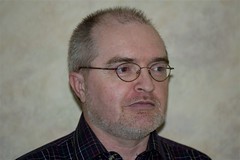 Yesterday, I had the privilege of providing feedback on a "dry run" for the technical track for the forthcoming Unified Communications Launch 2007 tour for Microsoft Canada.
Yesterday, I had the privilege of providing feedback on a "dry run" for the technical track for the forthcoming Unified Communications Launch 2007 tour for Microsoft Canada.To say I am impressed with Microsoft and the technology as an IT pro and an IT manager would be an understatement. I have to add that both those perspectives - IT pro and IT manager - are distinct and provide very useful ways of providing context to the technical presentations. More about that in a moment.
So why am I impressed? Some of it is about the mechanics and dedication of the people involved. Having now been part of two separate "dry run" experiences, it is readily apparent to me just how committed Microsoft Canada is to these launch tours. Presenters are grilled not once, but twice, in preparation for the tour, the first time to deal with content and overall objectives of each session, the second dealing more with fine-tuning, vocabulary choice, emphasis and tone.
The critical comments of "dry run" audience members are direct, sometimes brutally so. But the overall tenor is constructive and always delivered within a collateral objective of team building and empowerment. From my Toastmasters background, I find this very refreshing and another indication of why the corporate culture of Microsoft Canada is so highly regarded (among the top 10 for 2006 in the Canadian Corporate Culture Study).
Because these tours are so highly technical in nature, it is also critical that bugs be found and eliminated, and that both presenter and supporting audio-visual staff members feel comfortable with the technical components of the presentation.
But I am also impressed with the target audience analysis done by IT pro advisors and product managers. They know who will be attending these events and are constantly rehearsing how target groups will react to aspects of the presentations and demos.
Still, what impresses me most - beyond the way Microsoft Canada handles these event preparations - is the suite of technologies exposed by the moniker Unified Communications. As Damir Bersinic mentioned in a recent Canadian IT professionals blog post, incorporating these technologies into the overall IT environment means that IT pros will have to stretch once again. Telco pros know a lot that we don't, but we will have to learn much of what they know and do daily in order to make unified communications a reality in our environments. For the upcoming tour, this means that IT pros like me will have to listen very carefully to some of the telecommunications technical vocabulary, take copious notes, and be prepared to research those areas with which we are uncomfortable. But we've done it before and we can do it again.
But IT pros will feel very comfortable once the software demonstrations begin. Once presenters show Microsoft Exchange Server 2007, Microsoft Office Communications Server 2007, Microsoft Office Communicator 2007, Microsoft Live Meeting 2007 and the older Microsoft Office Live Communications Server 2005 - not to mention the show stopping Microsoft RoundTable - IT pros will feel right at home. Telephony will seem like just another software service.
As an IT pro, I look at these enabling technologies and realize that although the infrastructural details are intimidating, our end users will get used to the experience of unified communications very quickly. Like so much else of what we do, if we do it right, our "customers" won't even notice. End users will simply get used to identity and presence indicators in their Office software applications; they'll get used to starting instant message threads, conference calls, video conferencing and sharing of key collaborative documents with a click of the mouse and maybe a drag-and-drop operation. In a few days, it will be standard fare with productivity improving substantially. Sure, there are a lot of technical details we will have to master, but end-user training won't require much additional work for us.
As an IT manager, I look at these technologies and see business benefits staring right back at me. It won't take much to deliver these benefits and return-on-investment messages to business managers. Unified communications is, as Bill Gates said in an interview at the San Francisco launch, "taking your phone calls and making them far simpler and far more effective." That's the message. It doesn't get much simpler than that.
Whether you're an IT pro or an IT manager, make sure you get to one of these events.
